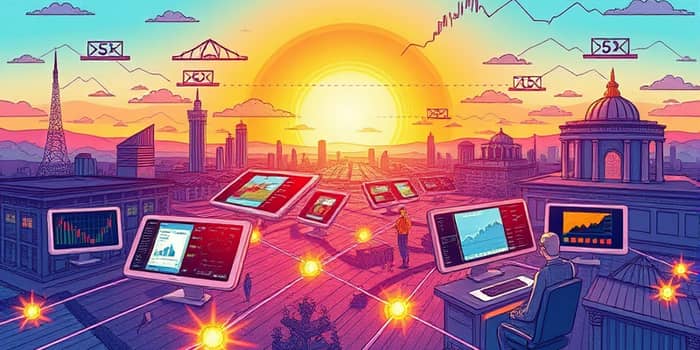
Imagine a world where every financial decision happens in the blink of an eye. With 5G networks redefining connectivity, that world is now within our grasp. This article explores how ultra-fast, reliable networks are reshaping trading, payments, and banking to empower individuals and institutions alike.
High-frequency traders and individual investors have long sought any edge to execute orders faster than the competition. Today, 5G delivers ultra-low latency with near-zero delays, reducing transaction time from tens of milliseconds to under one millisecond. This breakthrough means orders are filled almost instantaneously, allowing traders to seize fleeting market opportunities.
Beyond speed, 5G’s enhanced reliability and capacity ensure that thousands of users can trade simultaneously without network congestion. In volatile markets, when every microsecond counts, this translates directly to increased profitability and reduced slippage.
Key benefits for online trading include:
For algorithmic and high-frequency trading, 5G’s performance unlocks new strategies. Automated systems can now analyze millions of data points and execute multi-million-dollar trades in fractions of a second, leveling the playing field between institutional giants and agile individual investors.
Every tap, swipe, or wave at a point-of-sale terminal now happens in milliseconds. Contactless payments, long hailed for convenience, become truly frictionless with instant transaction confirmation powered by 5G’s speed.
In crowded venues—sports arenas, busy shopping districts, public transit—this faster processing reduces queues and enhances customer satisfaction. Merchants benefit from happier customers and lower abandonment rates, while consumers enjoy the ease of reliable, near-instant payments.
Security advances go hand in hand with speed. Real-time fraud detection systems driven by 5G can:
This shift from batch processing to continuous monitoring means financial institutions can prevent fraud in progress, rather than simply reacting after the fact.
Mobile banking has evolved from basic balance checks to comprehensive digital financial hubs. With 5G’s real-time mobile payments and ultra-responsive apps, customers enjoy unprecedented convenience and security on the go.
Imagine consulting with a personal banker via high-definition video, sharing documents instantly, and completing complex loan applications without delays. That vision is now a reality thanks to HD video conferencing over 5G and low-latency data transfer.
Financial institutions can use this capability to offer hyper-personalized services. By analyzing real-time behavioral and transaction data at the edge, banks deliver tailored advice and product recommendations exactly when customers need them.
5G doesn’t just speed up existing processes; it unlocks entirely new financial services. Decentralized finance (DeFi) platforms, blockchain-based trading, and smart contracts all thrive on low-latency secure connectivity. With 5G, peer-to-peer lending, tokenized asset trading, and cross-border settlements occur seamlessly and transparently.
Virtual banks can leverage network slicing to create dedicated digital lanes for different customer segments—premium, retail, or small business—ensuring consistent performance and tailored security. Edge computing further enhances these services by processing sensitive data locally, preserving privacy and reducing transmission delays.
As 5G networks roll out globally, financial institutions and individual users must prepare:
By embracing these changes, businesses gain a competitive advantage, and consumers enjoy smoother, safer experiences.
The fusion of 5G with artificial intelligence, Internet of Things, and blockchain sets the stage for a financial revolution. Imagine smart ATMs providing personalized advice, autonomous trading bots capitalizing on microtrends, and seamless global payments that feel as local as a neighborhood purchase.
Ultimately, 5G democratizes access to financial markets, breaking down geographic and technological barriers. From urban trading floors to remote villages, anyone with a 5G connection can engage in the global economy with confidence and speed.
As we stand at this transformative crossroads, one thing is clear: the future of finance is real-time, secure, and inclusive. Embrace the possibilities, harness the power of 5G, and become part of the next chapter in financial innovation.
References





